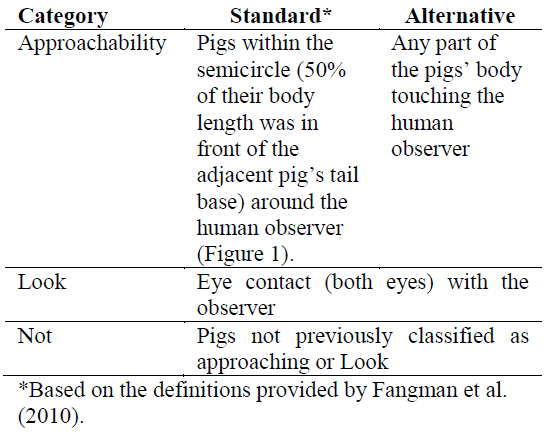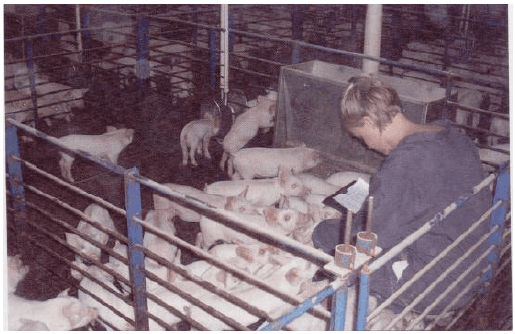Defining “Approachability” of Nursery Pigs
Published: July 9, 2012
By: Shawna Weimer, Anna Johnson, Kenneth Stalder, Locke Karriker, Thomas Fangman (Iowa State University)
Summary and Implications
The objective of this experiment was to compare two approachability definitions of nursery pigs to a human observer in their home pen using a digital image. A total of 79 pens in two rooms (40 in room 1 and 39 in room 2) were used. A total of 1,817, ~6 wk old mixed sexed nursery pigs, weighing ~25.4 kg were used. Two definitions for pigs reacting to a human in their home pen were compared. Determining the approachability of pigs followed procedures used by Fangman et al., (2010). The experimental unit was the pen of pigs. Data used to evaluate nursery pig behaviors failed to meet the assumption of normally distributed data. These data were analyzed by using the PROC GLIMMIX procedure of SAS. A P-value of ≤ 0.05 was considered to be significant for all measures. There were differences in the number of pigs classified as Approaching, Look, or Not based on the definitions. There were more pigs classified as Approaching and fewer pigs classified as Look and Not when using the standard definition for WTA compared to the alternative definition. Therefore in conclusion, the definition for "approachability" becomes important, if it were to be used for on-farm welfare assessment or auditing. Additionally, using approachability without Look and Not would not provide the external observer complete information on the pigs comfort level. In particular, when pigs are recorded as "Not" it is vital that further classification of behaviors and postures are recorded. For example, are pigs feeding, drinking, socializing or resting. These entire main and sub behavioral classifications can then result in an accurate assessment of pig behavior when presented with a human in their home pen.
Introduction
There is still no universally agreed and accepted behavioral methodology that can be conducted on-farm to assess a pigs´ approachability to a human in their home pen. This can be attributed to numerous challenges, for example, the sensory perception of the pig group size and previous caretaker-pig interaction. There have been numerous tests used to determine the level of fear in a variety of farm species, for example the open field tests, human and novel approach Fangman et al. (2010) coined the term "willingness to approach" as a more positive alternative to "fear", describing a pig approaching or looking at the human in their home pen. However, the term "willing" could be criticized as being too subjective. Therefore, the objective of this experiment was to compare two approachability definitions of nursery pigs to a human observer in their home pen using a digital image.
Materials and Methods
Animal care: Animal care and husbandry protocols for these experiments were overseen by the company veterinarian and farm manager. These protocols were based on the U.S. swine industry guidelines presented in the Swine Care Handbook (NBB, 2003) the Pork Quality Assurance Plus™ (2010). The protocol for this experiment was approved by the Iowa State University Institutional Animal Care and Use Committee. The experiment was conducted on 8 March 2011 at a commercial nursery site.
Animals and location: A total of 79 pens in two rooms (40 in room 1 and 39 in room 2) were used. A total of 1,817, ~6 wk old mixed sexed nursery pigs, weighing ~25.4 kg were used. There were ~20 pigs/ pen giving each pig 0.3 m2/pig.
Diets, housing and husbandry: The ceiling height in the nursery rooms were 2.6 m. Pens measured 1.8 m width x 3 m in length with steel dividers (81.3 cm height) between pens and one front steel gate at the front each nursery pen measured 91.4 cm height. Pens were situated with 10 pens on the right, 10 on the left and 20 in the center separated by two alleyways (76.2 cm wide). Feeders were green and circular with a radius of 55.9 cm and height of 81.4 cm (Osborne, Osborne, KS). Pigs has ad libitum access to a meal-grind diet (1510 kcal per kg metabolizable energy [ME] and 18.1% crude protein [CP] formulated to meet requirements (NRC, 1998). Diets were provided in a 5-hole feeder with a feed capacity of 76.2 kg. Each pen contained one stainless steel nipple drinker (Suevia Haighes, Kircheim, Germany) on the opposite side of the feeder, except for end pens where the drinker was located on the side of the feeder farthest from the alleyway. Polygrate flooring (12.7 mm gauge slats; Faroex Ltd., Gimli, Manitoba, Canada) was utilized in all pens. Twenty fluorescent lights were turned on at 7:00 am for daily chores and then were turned off around 16:00 pm. Two night lights were on 24-h a day. Rooms were automatically ventilated using either two pit fans (Osborne, Osborne, KS) with variable speed, 18 inlets and wall fans (Osborne, Osborne, KS) set at 5 CFMs/pig and contained two heaters (L.B. White, Onalaska, WI) per room set at 0.5 °C below set point. Average room temperature was 23.5°C. Caretakers observed all pigs twice daily.
Categories: Two definitions for pigs reacting to a human in their home pen were compared.
Table 1. Category definitions

Figure 1. Nursery pigs in a semi-circle around the observer (Fangman et al., 2010).

Approachability methodology: The observer entered the pen and walked to the right corner of then pen. She immediately crouched down, extended and held still the left leather-gloved hand and began a stop watch, avoiding eye contact with the pigs for a 15-s period. At the conclusion of the 15-s period, the observer raised her head, took a digital image using the wireless remote and simultaneously scanned the nursery pen to record three pig behavioral categories. After counting all pigs in the pen, the observer retraced her steps and exited the nursery pen. The observer then proceeded to all pens in the room in "a side-to-side fashion until all pens had been entered scanned and recorded (Fangman et al., 2010).
Statistical analysis: The experimental unit was the pen of pigs. Data used to evaluate nursery pig behaviors (WTA, Look and Not) failed to meet the assumption of normally distributed data. These data were analyzed by using the PROC GLIMMIX procedure of SAS. The statistical model for methodology included the fixed effect of definition (standard versus alternative),the random effect of room and a covariate of total number of pugs in a pen. A Poisson distribution was noted and used in the evaluation using PROC GLIMMIX procedures. Further, the I-Link option was used to transform the mean and SE values back to the original units of measure to better understand the results. A P-value of ≤ 0.05 was considered to be significant for all measures.
Results and Discussion
There were differences in the number of pigs classified as Approaching, Look and Not based on the definitions (Table 2). There were more pigs classified as Approaching and fewer pigs classified as Look and Not for those in the standard category.
Table 2. Number of pigs classifed as approaching, Look and Not.

Therefore in conclusion, the definition for "approachability" becomes important, if it were to be used for on-farm welfare assessment or auditing. Additionally, using approachability without Look and Not would not provide the external observer complete information on the pigs comfort level. In particular, when pigs are recorded as "Not" it is vital that further classification of behaviors and postures are recorded. For example, are pigs feeding, drinking, socializing or resting. These entire main and sub behavioral classifications can then result in an accurate assessment of pig behavior when presented with a human in their home pen.
Acknowledgements
Boehringer Ingelheim Vetmedica Inc. for funding.
This research report is part of the Iowa State University 2012 Animal Industry Report, supported by the Iowa Agriculture and Home Economics Experiment Station and originally published at the Iowa State University website, January 2012. Engormix.com thanks the researchers involved in this project and the Iowa State University for this huge contribution.
Related topics
Authors:
Join to be able to comment.
Once you join Engormix, you will be able to participate in all content and forums.
* Required information
Would you like to discuss another topic? Create a new post to engage with experts in the community.
Create a postDNL Farms Ltd.
9 de julio de 2012
I can believe that pigs in the picture are 6 weeks old. Did you check the accuracy of your scale?
How do you suppose changing pen size or changing age and size of pigs within a given space would affect results?
Did you check for changes in response to different handlers - could be a huge factor for onfarm assessments.







